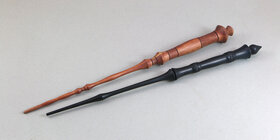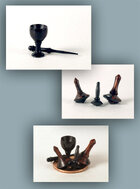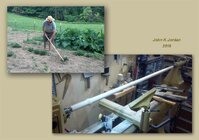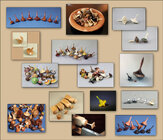That makes perfect sense - but if you could only have one, what would it be?
Difficult to answer. Still depends on the skewing being done and the size and type of things you want to turn.
For thin spindles, like these, I use a 1/2" skew along with a 3/8" spindle gouge

For miniatures and delicate finials, I use a 1/4" or smaller, maybe along with a 1/4" or smaller spindle gouge.

For things like gardening handles, I might use a 1" to 1-1/2":

For the handles of finger tops, I use spindle gouge or small skew. A gouge or 1/2" skew for straight facing cuts on the ends.

The biggest thing is I occasionally don't even know what skew I'll like for a new project until I experiment - can depend on the wood as well as diameter. I experiment as I go, make some cuts with one, switch to another, etc. For example, I find that thin spindles with certain specific blanks of osage orange will tear out splinters along the grain unless I use a skew with a larger included angle.
If starting out without a lot of skew experience, I'd recommend what I hand to students with no lathe experience:
- First, a 1-1/4" skew with a curved edge and a fairly large included angle (45-60-deg). Practice a lot with that.
- Then after some experience, give them a 1" then a 3/4" skew with a smaller included angle. Good for lots of things including drumsticks.
- When we advance to the trickier thin spindles (hairsticks, wands, conductor's batons, drop spindles for making yarn), a 3/4" skew then 1/2"
- When they want to do finials/ornaments it's usually a combo of 3/8" spindle gouge
However, what's I think is far better is visit an experienced skew user for some mentoring. (Many turning clubs have list of people willing to mentor, sometimes on specific things. They will often have a variety of skews and grinds and some experimenting might help you decide which to purchase first. Cheaper than buying a variety first and then experiment! (Unfortunately, my tool acquisition addiction sometimes prevents me from giving useful "what is best to get" advice.

)
...using the skew for roughing...I don't understand that concept. Supposedly the skew should be "scary" sharp ... time spent sharpening, honing/stropping, etc. Why beat the hell out of the edge by roughing out a turning square?
I often pick the skew to rough a square blank instead of reaching for a SRG. I find it can be quicker and cut cleaner with less tearout (with some wood). Depending. Yes, start with sharp. No, like using the skew in general it won't dull the edge.
This is not to say I don't like SRGs - I keep several at hand, different sizes and shapes. But I often use them for spindles with coves/curves or curves transitioning to cylinders or tapers. (I really like the SRGs with a semicircular bottom transitioning into straight, vertical sides. When moving down the wood, you can twist the gouge to the straight section and use it as a skew - nice way to dance with the shavings. Thompson's - and others - are ground like that.) I also like the contenental type of roughing gouge which is used as a big, shallow, spindle gouge.
One thing about roughing with a skew - use one with a width appropriate for the size of the blank! Too narrow can make a big mess.
As often recommended, if you can spend some time with an experienced turner they could show the tradeoffs and you could try the tools and techniques for yourself.
JKJ




